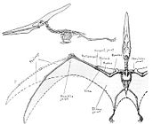
Pteranodontidae
Encyclopedia
The Pteranodontidae are a family
of large pterosaur
s of the Cretaceous Period of North America
.
The family was named in 1876 by Othniel Charles Marsh
.
Pteranodontids had a distinctive, elongated crest jutting from the rear of the head (most famously seen in Pteranodon
itself). The spectacularly-crested Nyctosaurus
is sometimes included in this family, though usually placed in its own family, the Nyctosauridae
(Nicholson & Lydekker, 1889).
Modern researchers differ in their use of the concept. S. Christopher Bennett and Alexander Kellner
have concluded that Nyctosaurus was not a pteranodontid. In 1994 Bennett defined a clade
Pteranodontidae, also including species of the Anhangueridae. However, this definition has not been accepted by other workers. Alexander Kellner, for example, named several additional species for specimens previously classified as Pteranodon, and placed P. sternbergi in a distinct genus, Geosternbergia
. Kellner re-defined Pteranodontidae as the most recent common ancestor of Pteranodon longiceps, Geosternbergia sternbergi and Dawndraco kanzai, and all of its descendants. This clade possibly includes the poorly understood Ornithostoma
, as well as the nyctosaurids
. Analyses by David Unwin did indicate a close relationship between Pteranodon and Nyctosaurus, and he used the name Pteranodontia for the clade containing both.
Family (biology)
In biological classification, family is* a taxonomic rank. Other well-known ranks are life, domain, kingdom, phylum, class, order, genus, and species, with family fitting between order and genus. As for the other well-known ranks, there is the option of an immediately lower rank, indicated by the...
of large pterosaur
Pterosaur
Pterosaurs were flying reptiles of the clade or order Pterosauria. They existed from the late Triassic to the end of the Cretaceous Period . Pterosaurs are the earliest vertebrates known to have evolved powered flight...
s of the Cretaceous Period of North America
North America
North America is a continent wholly within the Northern Hemisphere and almost wholly within the Western Hemisphere. It is also considered a northern subcontinent of the Americas...
.
The family was named in 1876 by Othniel Charles Marsh
Othniel Charles Marsh
Othniel Charles Marsh was an American paleontologist. Marsh was one of the preeminent scientists in the field; the discovery or description of dozens of news species and theories on the origins of birds are among his legacies.Born into a modest family, Marsh was able to afford higher education...
.
Pteranodontids had a distinctive, elongated crest jutting from the rear of the head (most famously seen in Pteranodon
Pteranodon
Pteranodon , from the Late Cretaceous geological period of North America in present day Kansas, Alabama, Nebraska, Wyoming, and South Dakota, was one of the largest pterosaur genera and had a maximum wingspan of over...
itself). The spectacularly-crested Nyctosaurus
Nyctosaurus
Nyctosaurus is a genus of pterodactyloid pterosaur, the remains of which have been found in the Niobrara Formation of the mid-western United States, which, during the late Cretaceous Period, was covered in an extensive shallow sea. The genus Nyctosaurus has had numerous species referred to it,...
is sometimes included in this family, though usually placed in its own family, the Nyctosauridae
Nyctosauridae
Nyctosauridae is a family of specialized soaring pterosaurs of the Cretaceous Period of North America and, possibly, Europe. It was named in 1889 by Henry Alleyne Nicholson and Richard Lydekker....
(Nicholson & Lydekker, 1889).
Modern researchers differ in their use of the concept. S. Christopher Bennett and Alexander Kellner
Alexander Kellner
Alexander Wilhelm Armin Kellner is a Liechtensteinian/Brazilian paleontologist, a leading expert in the field of the study of pterosaurs....
have concluded that Nyctosaurus was not a pteranodontid. In 1994 Bennett defined a clade
Clade
A clade is a group consisting of a species and all its descendants. In the terms of biological systematics, a clade is a single "branch" on the "tree of life". The idea that such a "natural group" of organisms should be grouped together and given a taxonomic name is central to biological...
Pteranodontidae, also including species of the Anhangueridae. However, this definition has not been accepted by other workers. Alexander Kellner, for example, named several additional species for specimens previously classified as Pteranodon, and placed P. sternbergi in a distinct genus, Geosternbergia
Geosternbergia
Geosternbergia from the Late Cretaceous geological period of North America, was one of the largest pterosaur genera and had a wingspan of up to .-Description:...
. Kellner re-defined Pteranodontidae as the most recent common ancestor of Pteranodon longiceps, Geosternbergia sternbergi and Dawndraco kanzai, and all of its descendants. This clade possibly includes the poorly understood Ornithostoma
Ornithostoma
Ornithostoma is a genus created in 1871 by H. Govier Seeley for a number of skeletal fragments, mostly of jaws, of toothless pterosaurs from the Upper Cretaceous Cambridge Greensand of England, today often assigned to the Pteranodontidae. One of these fragments had in 1859 been described by...
, as well as the nyctosaurids
Nyctosauridae
Nyctosauridae is a family of specialized soaring pterosaurs of the Cretaceous Period of North America and, possibly, Europe. It was named in 1889 by Henry Alleyne Nicholson and Richard Lydekker....
. Analyses by David Unwin did indicate a close relationship between Pteranodon and Nyctosaurus, and he used the name Pteranodontia for the clade containing both.

